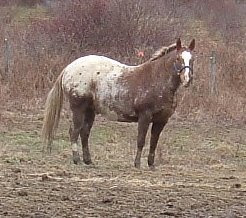Of course, when people see a horse like this, they know it's way too thin and probably needs to be/just was rescued :
Or if people see a horse like the one below, they instantly know it could use a better diet and a ton of exercise.
But in between these two extremes, people are often at a loss.
I frequently hear people talking about a horse similar to the one to the left and say "Oh, it's okay. He probably events/jumps/races." No. No,no,no. If a horse in this condition, irregardless of the breed, were to turn up at an event, the vet on site would most likely require the rider to scratch. The reason this horse isn't just "lean" is because of the way its fat and muscles fail to fill out its body. If you look at the neck, for example, it isn't a knife neck because the curvature is quite average, but its as narrow as the head from top to bottom almost the whole way down, and it drops down dramatically from the withers (which are large, yes, but there should not be that rise in the front). If you look at the spine from the withers to the dock, it's sticking out from the body, and the skin drops down sharply and hollows on either side before rounding out to follow the rest of the body's curvature. Look at the barrel. On a healthy horse, the barrel will appear to go straight out from the chest for a bit before sloping up to the stifle. On this horse, it cuts straight up at about a 20 degree angle. Finally, its hip and buttock are good indicators of weight. They protrude sharply from the body rather than be round and "not pointy" in appearance.
Many people will also look at a horse like this and say, "Maybe it does dressage, or is just a pasture horse," or event, "But ponies are supposed to be/are cute when they're fat!" I don't care if you like fat ponies, it's unhealthy. You're shortening the animals life unnecessarily by keeping it overweight. Anyway, this horse to the left is, indeed, overweight no matter what it's for. Again, look at the neck. It has a fleshy appearance the whole way down, especially down the crest. If you look at the horse's spine (it's easier to see from a higher angle), and it appears to dip, even slightly, where the bones would be, the horse is fat. Look at this horse's barrel. Rather than go straight and slope upwards, it immediately dips down below the chest in what I call a hay belly before sloping back up. The angles on the barrel give it the appearance and shape of a yoga ball. Finally, look at its hind end as a whole. It has a fleshy appearance and even has some fat pockets sticking out. You can't discern the hipbone or the buttock bone (don't know bone names) from the rest of the hind quarters because the whole shape is round.
Of course, how a horse's natural weight will look depends on breed and skeletal frame, but, in general, the horse to the left is what you want. You can very slightly see bone structure, but not so much you can look at the horse and be like, "I see its spine. Hmm..," and the horse isn't also so round you immediately think of a fluffy pony or a bareback ride. Whether or not you work to keep your horse fit, you should work to keep it at a good weight to prolong its life, protect it against disease, and help its joints (heavy horses break down much faster, the same with humans).

No comments:
Post a Comment